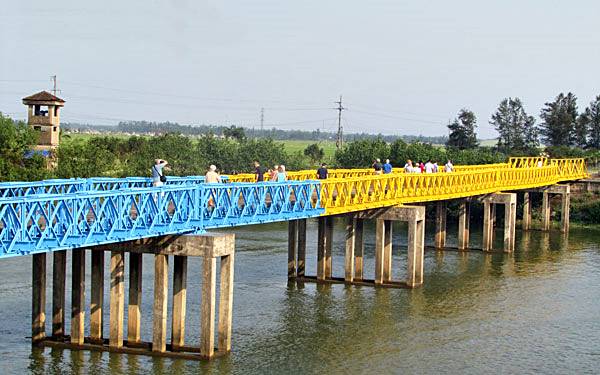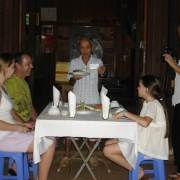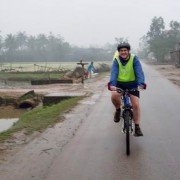Surprise in Phong Nha cave trip- Porper story #13
This Phong Nha cave trip day is the thirteen post in a series of Vietnam experiences storied by Rochelle Porper, for the previous ones please read these.
- Greeting from the other side of the world – Porper story #1
- Days of Saigon streets and Mekong boat trip – Porper story #2
- Vietnam war confronting – Porper story #3
- A massage adventure in Saigon – Porper story #4
- First hit to highland Vietnam tour – Porper story #5
- Vietnam rain forest and hills of plantations – Porper story #6
- Kontum, tomb houses and tribal villages – Porper story #7
- On the way to hoi an ancient town – Porper story #8
- Hoian farming day – Porper story #9
- Another day in paradise – Porper story #10
- On the way to hue – Porper story #11
- Hello from Hue – Porper story #12
Well, who knew that this hotel had been upgraded with Internet access! As far as I can tell, it’s the best feature it offers but beggars cant be choosers. Long said it was a three star hotel but after being here awhile, I wonder which universe those stars are from…

So I woke up this morning to the sound of the rain pounding on the palm leaves outside my window. It was such a nice sound, but unfortunately, I will go to bed listening to the same pounding 12 hours later. It is possible that the heat has given way to the rain, but I hope not because the best is apparently yet to come. I couldn’t eat breakfast this morning because my stomach was still roiling from the day before. I sat in the breakfast room and drank coffee and thought a lot. I decided that it wasn’t really just the visit to Long’s house that had me upset but more of my trying to put the pieces of this enormous puzzle together. Usually when you have an experience that is as profound as this one, it takes awhile to let it all sink in. I feel like I am on an accelerated course of my own re-education. It is taking some time to figure it all out, but it’s a good process and worth the investment of time.
Before I get into the events of the day, I wanted to respond to a question that was asked about the monk burning incident. Because it was such a seminal event in Vietnam’s history, I will share the story with you. What we heard in the US about why the monk burned himself alive wasn’t the complete truth. Allegedly, it was to protest the removal of a Buddhist holiday by the Catholic South Vietnamese government led by Diem. In fact, according to Long, Diem himself was not a Catholic and didn’t really care one way or the other about the Buddhists. But his brother was a staunch Catholic, and if he reached a certain quota of converting Buddhists to Catholics, then he got promoted to a Cardinal and this appealed to Diem because it gave him more power. So the removal of the Buddhist holiday was a tactic in a larger strategy. When the monk decided to protest, the members of the temple tipped off the media but kept the event a complete secret from the South Vietnamese government, which was embarrassed by the event on a global level, and backed off on their assault on Buddhists. So there you have it.
So on with the events of the day. We hop in the van and we know we have a long day today. A 4 hour drive in the morning and a 4 hour drive in the afternoon but in the middle, a spectacular outing that I will tell you about later. Long has come with several magazines that he tries to pawn off on us to read about the culture, but they are filled with such bad Vinglish that we toss them aside and demand more stories (for example, a quote from one of the magazines “Bare sandals feet walked with long distance in series on sand in picture of long lines sea snakes’. Useless).

As the topography changes from lush to sandy and we enter the province of Quang Tri, of course we start talking about the war again. This is a province that both Sam and I vividly remember hearing about as youngsters, so we want to learn more about it. This is where perhaps the fiercest fighting of the war occurred because it abuts the DMZ. Ironically, both the general of North Vietnam and the general of South Vietnam were from Quang Tri. Soldiers who came here knew they were never coming back, and would send diaries and all of their personal effects home to their families once they arrived.

There is a cemetery here (which Long calls a gravery) with over 1 million gravestones. We hear about the tactics that were used by the Americans that are news to me. For instance, did you ever hear about McNamara’s electric fence? I don’t know why it was called that, but it was really a series of magnetic bombs that were bombs dropped from the air but which sat on the ground unexploded until something metal came into contact with it. We also dropped a series of sensors that looked like trees all along the border of Vietnam and Laos, and they recorded the voices and the smells of the Vietcong so we could determine where they were and what they were doing before launching an attack.

And then there was the story of Hamburger Hill – another name we were familiar with but couldn’t remember the story. After hearing it, I cant imagine that the media accurately reported what really happened there, but let me know if you recall differently. This particular hill had been captured by the Americans, and there were about 1 – 2000 soldiers posted at the top because of its strategic importance. At some point, the hill was surrounded by 10,000 Vietcong, and the Army realized that our soldiers could not survive an attack. They were so concerned that the men would be captured and used as POW bargaining chips that they made the decision to bomb the entire hill, killing both the Americans and the Vietcong. Hence, the name Hamburger Hill because there was so much blood and blown up bodies that it resembled ground meat. I was completely stunned by this story, but maybe I am naive and this happens in war all the time. But killing your own men???

Anyway, Quang Tri province continues to be haunted by the impact of the war. There are over 800,000 pounds of unexploded landmines scattered through out this area, and over 7000 people have died post war as a result. Unfortunately, most of these are children because they are responsible for grazing the water buffalo and the metal on the carts they are pulling sets off the magnetic bombs.

However, in the interest of fair and accurate reporting, I have to tell you that the North Vietnamese had their own issues. There are two dark chapters in their history that are equally gruesome. The first was the Tet Offensive, again a term that Sam and I were familiar with but really had no clue as to what it referred to. This occurred when the North Vietnamese decided it was time to take over the South and, as they have proven over and over again, came up with a very clever idea to pursue this goal. They waited until the Vietnamese New Year, which is a huge celebration here, because they knew all of the soldiers from the South would go home to celebrate with their families. Then they brutally took over the biggest cities to the South and went on a rampage killing innocent civilians. They would come knocking on people’s doors and if they couldn’t prove they supported the Communist regime, they would murder them on the spot. Long’s grandmother barely escaped alive when the soldiers came to her village. The second dark chapter is euphemistically referred to as the Land Revolution. That’s when laborers, under the guise of good Communism, went after the rich land owners because owning land was not a very Communist thing to do. They would bury these land owners up to their heads in the dirt and then have the water buffalo drag the plows over them.

OK – enough of the history lesson for today. Maybe because I am here, I find all of this so interesting but I also find it compelling because we were so intimately involved. Anyway, after this discussion, I was on overload and had to lie down in the van and take a nap. It was too much. When I woke up, we had arrived at our destination, which I have to say is one of the most spectacular places I have ever seen, and probably will see (until Thursday, when we get to Halong Bay). We visited the largest wet cave (meaning a river runs through it) in the world.

To get there, we have to take a long boat ride. Fortunately, the boat has a cover because the rain is pounding on the river so hard that it splashes into the boat. The river is surrounded by these tall hills which are covered in vegetation but are mostly shrouded by the clouds. The clouds look like they are floating on the river. Along the way, we see people trolling the river for weeds to feed the pigs. Very industrious, and they never stop working.

Finally we get to the cave, and I know I will fail miserably in describing it. This is cave that you can only get to by boat, and the river is so wide that three boats can float side by side as you are looking around. There are huge stalactites and stalagmites hanging up and down and there are colored lights highlighting the caves within the caves. We can’t get over how spectacular it is. You can hear the water cascading down the huge cave walls and sometimes it cascades on your head.

The cave is over 230 million years old and hasn’t been totally excavated yet because at some point passed where we are allowed to go; there is not enough oxygen to support breathing. This place was absolutely magical – almost like an enclosed Grand Canyon. You had the opportunity to climb out of the boat and walk around, and I wish I could describe the feeling. For some reason, the way the limestone has eroded reminded me of the Men from the Dead from the third Lord of the Rings movie – you know those feathery looking skulls that fight the last fight? It was wild. The only problem was that the Vietnamese don’t really understand, or care to understand, how delicate that ecosystem is so they were climbing the long columns of limestone for good photo ops. We were appalled and Long tried to talk some sense into them, but it was useless.

So that really was our one good excursion for today. The second 4 hours in the van were way too long, but the scenery was beautiful. Huge rolling hills completely covered in lush vegetation (yeah, blah blah blah). We heard some stories about a remote tribe that live in this part of the country that have no contact with the rest of society and wear clothes made of tree bark. They speak a different language, eat unusual food, and only have 90 members left to the tribe. No doubt they won’t last much longer.

Its anybody’s guess what tomorrow will bring, but I am sure it will be an adventure. Our group has really developed a nice kinship. We laugh a lot and really enjoy each other’s company. This makes the long hours in the van bearable. Plus Long’s English, at times, is hysterical (remind me to tell you the telephone story…).
Ciao.
by Rochelle Porper from Boston, Massachusetts, USA
For the next ones among this Vietnam travel experience, you can jump to the following days.















Leave a Reply
Want to join the discussion?Feel free to contribute!